

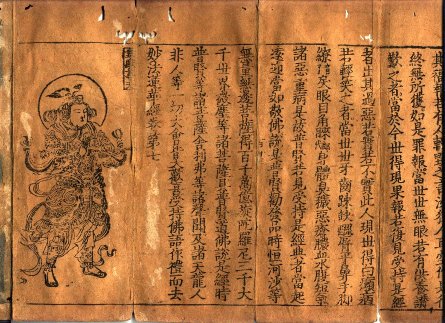
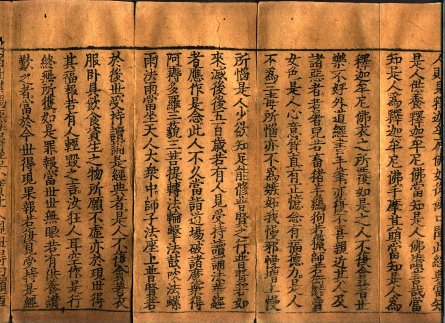




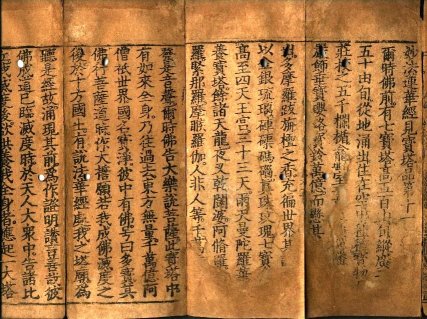
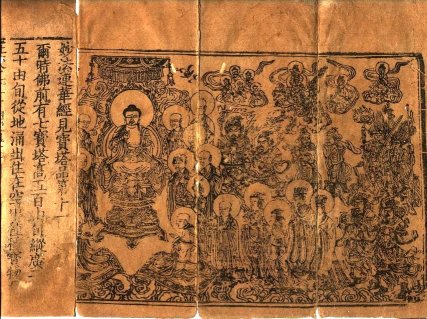
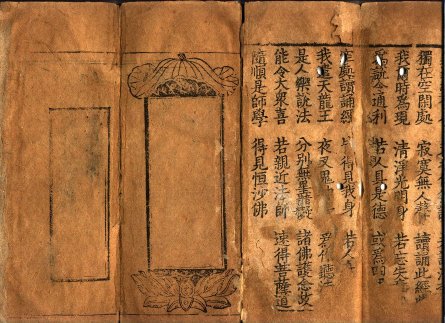
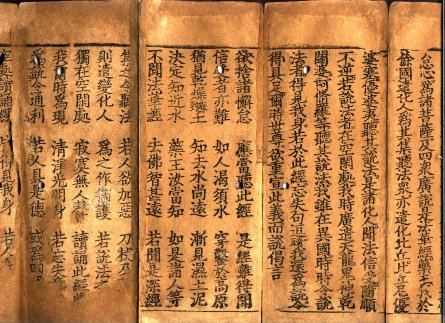
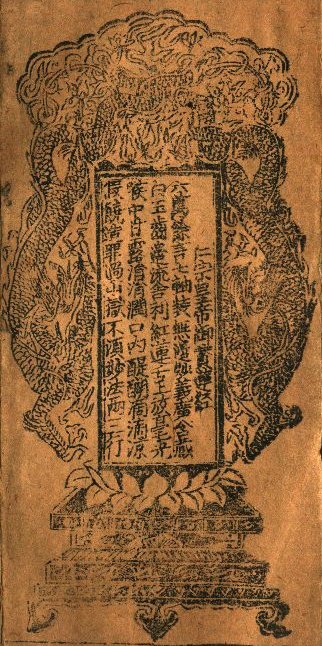
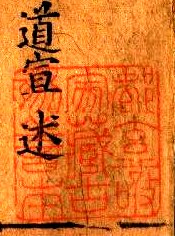
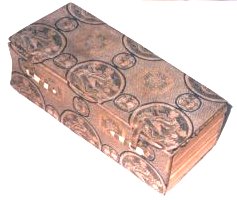
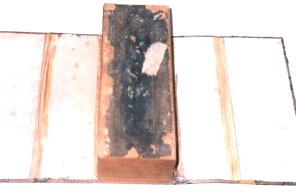
A Song Dynasty Woodblock Print of Lotus Sutra 妙法蓮華經 (Miaofa lianhua jing)
Dated (1022-1063)
The official name for this sutra is the Scripture of the Lotus Blossom of the Fine Dharma, but most people just call it the Lotus Sutra (Hokkekyo in Japanese).
The Lotus Sutra was preached by Shakyamuni Buddha in the eight years before he entered Nirvana. It is the Buddha's ultimate teaching i.e. the most final Dharma, containing his final revelation on the universality of salvation, the true nature of Buddhahood, and the best and universally applicable means of attaining Buddhahood.
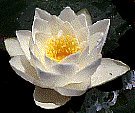 In Buddhism, the
lotus flower is considered to be a holy flower because it grows
up pure and white from even the muddiest swamp. Lotuses are
flowers that grow in large swamps or marshes and look very much
like water lilies. They have large roots with holes in them that
can be eaten as a delicious, crunchy vegetable. While lotus
patterns have become symbols of Buddhism, the holiness of the
lotus pond and the sight of lotuses blooming on the surface of
the water have come to symbolize the Buddha's "Pure
Land," or heaven.
In Buddhism, the
lotus flower is considered to be a holy flower because it grows
up pure and white from even the muddiest swamp. Lotuses are
flowers that grow in large swamps or marshes and look very much
like water lilies. They have large roots with holes in them that
can be eaten as a delicious, crunchy vegetable. While lotus
patterns have become symbols of Buddhism, the holiness of the
lotus pond and the sight of lotuses blooming on the surface of
the water have come to symbolize the Buddha's "Pure
Land," or heaven.
the Lotus Sutra is an amazing scripture. It tells us how profound and infinite the Buddha's wisdom is--that enlightenment is not something that can be grasped as an intellectual concept, that it cannot be fully expressed in words. While praising the Buddha's wisdom in this way, it also declares that the purpose of the Buddha's appearance in the world is to make this ineffable wisdom accessible to all beings and enable them to attain enlightenment. The Lotus Sutra also emphasizes that it is expounded for this reason, and that all who hear it will attain Buddhahood without fail. The sutra states again and again that, even after the Buddha's death, a person who hears the Lotus Sutra and commits so much as a single phrase or verse to memory will, without fail, attain Buddhahood."
The Lotus Sutra was first translated into Chinese in the 3rd century AD. In the 6th century the Chinese monk Zhiyi founded a monastery on Mount Tiantai where he taught his comprehensive interpretation of the sutra. He organized all existing Theravada and Mahayana sutras into a five-part scheme, comprising the various levels of teaching revealed by the Buddha and culminating in the Lotus Sutra, the supreme synthesis of Buddhist doctrine. Tendai thus became proverbially broad, able to absorb and give rise to other movements within Buddhism. It also took up a principle of threefold truth derived from Nagarjuna: (1) all things are void and without essential reality; (2) all things have a provisional reality; (3) all things are both absolutely unreal and provisionally real at once. The transient world of phenomena is thus seen as one with the unchanging, undifferentiated ground of existence. This doctrine was elaborated in a complex cosmology of 3,000 interpenetrating realms of existence.
This copy of the Lotus Sutra was based on a translation by a monk in Eastern Jin Dynasty of China (東晉) (A.D. 317-420). It was printed for Song Ren Zong (宋仁宗 , a Northern Song Dynasty Emporer) era (1022-1063) by woodblock printing method. Block printing started in China in the 7th c., but no examples survived. The oldest surviving printing was found in 1966 in a stupa in the Buddhist temple Pulguk-sa, Kyongju, Korea. This is almost 700 years before Gutenberg re-invented printing in Europe around 1450.
Please Click Here For An English Translation of the Scripture
Click Here to See Other Scanned Images of the Book
妙法蓮華經弘傳序
唐終南山釋道宣述
妙法蓮華經者,統諸佛降靈之本致也。蘊結大夏,出彼千齡。東傳震旦,三百餘載。西晉惠帝永康年中,長安青門、燉煌菩薩竺法護者,初翻此經,名正法華。東晉安帝、隆安年中,後秦弘始,龜茲沙門鳩摩羅什、次翻此經,名妙法蓮華。隋氏仁壽,大興善寺、北天竺沙門闍那、笈多、後所翻者,同名妙法。三經重遝,文旨互陳。時所宗尚,皆弘秦本。自余支品、別偈,不無其流。具如敘歷,故所非述。
夫以靈嶽降靈,非大聖無由開化。適化所及,非昔緣無以導心。所以仙苑告成,機分小大之別。金河顧命,道殊半滿之科。豈非教被乘時,無足核其高會。是知五千退席,為進增慢之儔。五百授記,俱崇密化之跡。所以放光現瑞,開發請之教源。出定揚德,暢佛慧之宏略。朽宅通入大之文軌,化城引昔緣之不墜。繫珠明理性之常在,鑿井顯示悟之多方。詞義宛然,喻陳惟遠。自非大哀曠濟,拔滯溺之沈流。一極悲心,拯昏迷之失性。
自漢至唐六百餘載,總歷群籍、四千餘軸。受持盛者,無出此經。將非機教相扣,並智勝之遺塵。聞而深敬,俱威王之餘績。輒於經首,序而綜之。庶得早淨六根,仰慈尊之嘉會。速成四德,趣樂土之玄猷。弘讚莫窮,永貽諸後云爾。